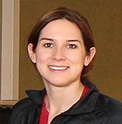Master of Science in Nursing in Nursing Administration Online
Become an agent of change by improving patient care. Advance your career with enhanced leadership skills that position you to drive transformative change at the frontlines of healthcare.
Home > Online Programs > MSN > Master of Science in Nursing in Nursing Administration
Program Overview
Enhance your nursing leadership with the online MSN in Nursing Administration program
Renowned for developing nursing leaders, The University of Texas at Arlington College of Nursing and Health Innovation prepares you for success in nursing management. The online Master of Science in Nursing (MSN) in Nursing Administration program incorporates contemporary management theory and core competencies to help you become a top candidate for competitive leadership roles in healthcare.
UTA’s prestigious online MSN program centers on critical aspects of administration while preparing you to improve career mobility, empower clinical nurses and lead superior patient care. Building on a foundation of undergraduate nursing education and practical experience, this advanced program encourages you to apply your field knowledge for broader impact while you access an improved work-life balance.
Key highlights of UTA's online MSN in Nursing Administration program include:
- Advanced healthcare management theory
The program highlights core concepts experienced in a workplace environment inclusive of nursing theory, research, evidence-based practice, nursing informatics, management, leadership, financial management, nursing operations, roles and functions of the nurse administrator, and healthcare policy - Applied learning through practicum experience and expert faculty coaching
Practicum experiences occur through application of knowledge learned in healthcare facilities in which administrative senior nurses are present. UTA faculty guide, coach and mentor you in the practicum assignments. Course content is delivered via a blended learning model and online technology-enhanced courses. - Accelerated program format increasing your speed to impact
Our instructional format is not linked to traditional semester schedules, which allows you to enter and progress through the program in an expedited manner - A launchpad for future development
Work toward qualifications to apply for national certification exams in nursing leadership and nursing administration offered by ANCC and AONL and/or academic progression to doctoral PhD or DNP programs
Notably accredited by the CCNE, the program advances your leadership skills and prepares you to pursue high-impact roles, such as:
- Chief Nursing Officer (CNO)
- Nurse Administrator
- Program Administrator
- Director of Case Management
- Chief Nursing Officer (CNO)
- Nurse Administrator
- Program Administrator
- Director of Case Management
State Authorization
Residents of certain states may not be eligible to enroll in all UTA accelerated online programs. See program map for details. Currently enrolled students who reside in ineligible states will need approval to continue uninterrupted in their programs in accordance with applicable state laws. Approval is not guaranteed.
Also available:
UTA offers a wide variety of nursing programs online. Check out all of our online nursing programs.
Accreditation
The baccalaureate, master's and Doctor of Nursing Practice degree programs and the post-graduate APRN certificate program in the College of Nursing and Health Innovation at The University of Texas at Arlington are accredited by the Commission on Collegiate Nursing Education.
"...Having my master's degree has helped me get to where I am."
Ashley Hodo, UTA MSN online graduate
Tuition
Choosing our online program is cost-effective
The University of Texas at Arlington is committed to providing students with a quality, affordable education. That's why this online program offers pay-by-the course options.
| Per Credit Hour | Per Course* | Per Program |
|---|---|---|
| $494.44 | $1,483.33 | $17,800 |
Tuition Guarantee
Did you know if you enroll now and complete your program without interruption, you can lock in your tuition rate? Read more
Tuition breakdown:

“For me, online education was the only option I had, since I had a Monday-through-Friday job with young children. Really, I couldn't have asked for an easier way to go back to school. It really was great.”
Kelly Ward
UTA MSN online graduate

“In the leadership classes, you learn a lot of different types of processes and even doing case studies where you're talking about different ways to engage things. I learned a lot of management and leadership skills. It's challenging, but you won't regret it when you're done. You'll be glad you did it. It does open up doors and also helps you grow in your career.”
Joy Smoot
UTA MSN online graduate
Calendar
Our course schedule is designed for flexibility
The MSN in Nursing Administration online program offers multiple start dates to accommodate your professional and personal schedule.
| 8-week courses | Program Start Date | Application Deadline | Document Deadline | Payment Due |
|---|---|---|---|---|
| Summer II | 6/30/25 | 5/30/25 | 6/13/25 | 6/27/25 |
| Fall I | 8/18/25 | 7/18/25 | 8/1/25 | 8/15/25 |
| Fall II | 9/29/25 | 8/29/25 | 9/12/25 | 9/26/25 |
| Fall III | 11/3/25 | 10/3/25 | 10/17/25 | 10/31/25 |
| Spring I | 1/12/26 | 12/12/25 | 12/19/25 | 1/9/26 |
| Spring I | 2/16/26 | 1/23/26 | 1/30/26 | 2/13/26 |
| Spring II | 3/30/26 | 3/6/26 | 3/13/26 | 3/27/26 |
Now enrolling:
Ready to take the next steps toward earning your degree?
Admissions
Ready to apply? Check our admission requirements for the online MSN in Nursing Administration
The College of Nursing and Health Innovation admission process is the first step toward changing your life and enriching the lives of others. Familiarize yourself with these admission requirements, along with information on required documentation.
Admission Requirements
- Online application
- Official transcripts
- Active RN license
- Work experience*
Online Admission Requirements
- Unconditional admission for students with a 3.0 GPA or higher
- Probationary admission for applicants with 2.8-2.99 GPA
- Graduate School requires that the BSN come from a university that is regionally accredited. The College requires that the Nursing program be CCNE or ACEN accredited.
- Undergraduate (basic) statistics course with a minimum grade of "C"
- Applicants must possess an unencumbered RN license.
- International students are required to have a TSE score of 40 or higher. The Test of English as a Foreign Language (TOEFL) exam is required if the applicant's native or first language is not English and if he or she does not hold a bachelor's degree from an accredited U.S. institution. TOEFL score requirement includes minimum of 550 on paper-based test, 213 on computer-based test, or 79 on the internet-based test, and achieve the following minimum scores of subtests: Writing, 22; Speaking, 21; Reading, 20; and Listening, 16; or IELTS minimum score of 7.0
*Applicants who meet all the admission requirements listed above but have fewer than 2 years of clinical experience may be granted provisional admission.
Have a question? Call us at 866-489-2810.
Learn more about our admission requirements, review the nursing handbook and policies, and discover tips for success on the UTA College of Nursing and Health Innovation (CONHI) page.
Courses
Take a look at the online MSN Nursing Administration curriculum
The MSN in Nursing Administration program consists of 12 courses. MSN degree courses vary in length from 5 to 10 weeks. Students must follow the exact sequence of courses as prescribed by the College of Nursing.
Students may earn an Advanced Nursing Educator Certificate by taking an additional twelve nursing education credits with their program. For more information, please contact your advisor.
Due to the rigorous nature of the graduate nursing program and the time commitment of the coursework and clinical, students can expect to spend a significant amount of time studying and preparing required assignments. Generally, a student will be expected to spend 5 hours per week outside the class room for every 1 credit hour of the course. This means a 3 credit-hour class would require approximately 15 hours per week of student study time. Given this, it is strongly recommended that accepted applicants limit work schedules to keep up with the academic rigor of the program.
Additional Information
Students may earn an Advanced Nursing Educator Certificate by taking an additional twelve credit hours with their program. For more information, please contact your advisor.
Due to the rigorous nature of the graduate nursing program and the time commitment of the coursework and clinical, students can expect to spend a significant amount of time studying and preparing required assignments. Generally, a student will be expected to spend 5 hours per week outside the class room for every 1 credit hour of the course. This means a 3 credit-hour class would require approximately 15 hours per week of student study time. Given this, it is strongly recommended that accepted applicants limit work schedules to keep up with the academic rigor of the program.
To see which courses are going to be offered on each start date, download the course schedule.
* Per-course tuition based on 3-credit hour courses.
Request More Information
Submit this form, and an Enrollment Specialist will contact you to answer your questions.
Or call 866-489-2810
By submitting this form, I am providing my digital signature agreeing that The University of Texas at Arlington (UTA) and its agent, Risepoint, may email me or contact me regarding educational services by telephone and/or text message utilizing automated technology or a pre-recorded message at the telephone number(s) provided above. I understand this consent is not a condition to attend UTA or to purchase any other goods or services. Privacy Policy. SMS Terms.
Ready to Begin?
Start your application today!